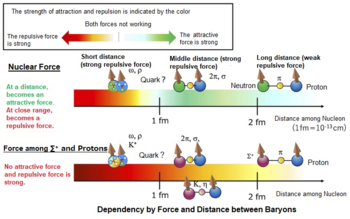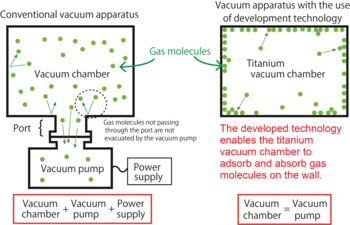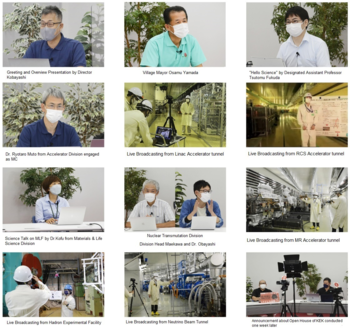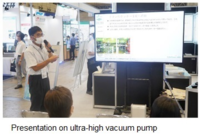J-PARC News October 2022(Issue #209)
■Capturing the "Core" between Quarks - Contributing to the understanding of why matter can exist stably (Press Release on September 5)
Nuclear force appears between nucleons, such as protons and neutrons, and works as an attractive force at a distance where two nucleons do not overlap. However, when two nucleons are close enough to overlap, the force changes to a repulsive force. Furthermore, when the overlap becomes larger, the repulsion rapidly becomes stronger as if a "core" exists. These properties of nuclear forces contribute to the stable existence of matter. One of the main sources of the repulsion is thought to be the "Pauli principle at the quark level". However, experimental information on the strength of the repulsion has been completely absent.
The E40 group, an international collaboration consisting of Tohoku University, Kyoto University, KEK, JAEA, Osaka University, and other institutions, has succeeded in the world's first high-precision measurement of the differential cross section of the scattering between the Σ+ particle, containing strange quarks, and the proton, at the Hadron Experimental Facility in J-PARC. The differential cross sections sensitively reflect the forces between particles. Moreover, the ∑+ and the proton have a Pauli forbidden state at the quark level leading the repulsion between them.
The nuclear force between protons and neutrons at distances where the two scattering particles overlap by about 30% is attractive, and the current measurements show that the repulsion between the ∑+ and the proton is twice as strong as that attraction. Further understanding of repulsion of nuclear force at the short distance is expected since the experiment determined the strength of the Pauli repulsion between quarks, which was previously unknown.
For more information, please visit the J-PARC website.
https://j-parc.jp/c/press-release/2022/09/05001005.html
■Energy-saving and space-saving! The invention of an Ultra-High Vacuum Getter Pump Utilizing Titanium - A Major Contribution to a Carbon-Neutral Sustainable Society! -(Press Release on September 6)
At J-PARC, we have developed technology to utilize vacuum chambers made of titanium as ultra-high vacuum pumps that do not require power supplies. We have also demonstrated that this technology improves the vacuum performance of an electron microscope by using a prototype.
We have been using titanium in the accelerator beamlines at J-PARC and studied heat treatment and surface polishing to reduce the gases released from titanium materials into the vacuum. In our current research, we focused on titanium's getter performance, in which it adsorbs and absorbs gases. Then, by modifying the surface of a titanium vacuum chamber, we made the vacuum chamber itself act as an ultra-high vacuum pump. This vacuum chamber-type ultra-high vacuum getter pump has proven that once a vacuum is created, an ultra-high vacuum can be maintained for more than 200 days without evacuation by the conventional vacuum pumps. Furthermore, we have confirmed that vacuum performance of electron microscopes can be improved by an order of magnitude by attaching the prototype.
This technology can be used for containers to transport semiconductor chips and other components while maintaining a vacuum without a power source, and can also lead to downsizing and power saving of semiconductor manufacturing equipment, making a significant contribution to a carbon-neutral sustainable society.
The results of this research have been published as a patent (JP 2022-027577).
For more information, please visit the J-PARC homepage.
https://j-parc.jp/c/press-release/2022/09/06001006.html
■J-PARC Online Facility Open House 2022 Held
Thank you very much to all viewers watching (August 27)
We held our open house online, as we did last year and the year before. This year's title was "Only Online! The deepest part of J-PARC!" By combination of live broadcasts and pre-recorded videos from the accelerator and experimental facilities, we provided programs showing deep in-site of J-PARC with usually unavailable talks by researchers. These were broadcasted via YouTube and niconico Live Broadcast.
During the open house, we also held "Hello Science", the monthly science café, at which Dr. Tsutomu Fukuda, designated assistant professor of the Institute of Materials and Systems for Sustainability Advanced Measurement Technology Center (AMTC) Elementary Particle Measurements Section of Nagoya University, gave a lecture on the theme of "Studying Particle Neutrinos and the Mysteries of the Universe with Photographic Film". In his talk, he also shared episodes from his overseas experiences. We appreciate all the viewers who participated in the "Ask Questions on Zoom!" at "Hello Science".
The video of the day's event can be reached at following web sites.
YouTube https://www.youtube.com/watch?v=r_B3dYFplJg
niconico Live Broadcasting https://live.nicovideo.jp/watch/lv337870337
■Exhibited at JASIS 2022 on September 7-9 at Makuhari Messe International Exhibition Hall
JASIS2022, the Japan's leading-edge scientific instruments, analytical system & solution exhibition, is one of the Asian largest exhibitions in this field. The Materials and Life Science Experimental Facility (MLF) at J-PARC and the research reactor JRR-3 at JAEA have instruments that utilize neutron beam to analyze the structure and dynamics of atoms and/or molecules in various materials. At the exhibition under full precaution of COVID-19, we introduced our research topics carried out MLF and JRR-3 as we held last year. In addition, through the promotion of the utilization of our facilities, we aimed to co-create with different research fields and to realize socially implementation of our results to collaborative creations. One a topic of this year's our exhibition, we had presented the ultra-high vacuum pump made of titanium (see the article of the press release), which has been developed in the Accelerator Division of J-PARC center, in which many of visitors had interested. In addition, we also introduced widely other JAEA's intellectual properties which can be applied to industrial fields, together with the portal site for the facility utilization.
Nearly 1,500 visitors, many of whom listened intently to the researchers' explanations, visited our booth during the exhibition.
■11th International Workshop on Sample Environment at Scattering Facilities on August 28-September 1 at Nasu, Tochigi prefecture, Japan
"11th International Workshop on Sample Environment at Scattering Facilities" was held at Nasu in Tochigi Prefecture, Japan, jointly organized by J-PARC Center, Center of Neutron Science for Advanced Materials of Tohoku University, Comprehensive Research Organization for Science and Society, Frontier Research Center for Applied Atomic Sciences of Ibaraki University, Institute for Solid State Physics of the University of Tokyo, Japan Synchrotron Radiation Research Institute, KEK Institute of Materials Structure Science, and Materials Science Research Center of Japan Atomic Energy Agency. That is the workshop of the International Society for Sample Environment and has been held almost every two years since 1999 for researchers and engineers who work on the development and operation of sample environments at neutron and synchrotron radiation experimental facilities around the world. Originally, the 11th workshop was planned to hold in 2020. However, due to the COVID-19 pandemic, it was held four years after the last one. Eighty-seven researchers and engineers participated in the workshop and contributed oral and poster presentations on the current operation status of the sample environment and development of new technologies. In addition, international cooperation in these pandemic times was also discussed. The sample environment community in Japan is not as well established as in other countries. Despite this, there were many Japanese participants who were willing to support the first sample environment workshop in Japan. We hope that, through this workshop, the information exchange on the sample environment technologies will be promoted among the neutron and synchrotron radiation facilities in Japan.
■Sanpomichi ㉗ -Summer Vacation Intern Visits-
Many students took advantage of summer vacation and visited J-PARC as summer vacation interns. We believe that this is one of the most important public relations activities at J-PARC, as it is a valuable opportunity to meet with visitors face to face. Restrictions on visits due to COVID-19 have gradually been lifted, and J-PARC is beginning to regain its liveliness with visitors little by little.
From a visitors' perspective, the face-to-face visit is an opportunity to listen to explanations until they understand, focusing on areas of interest. On the other hand, in the terms of the PR section staff, it is a good opportunity to learn what visitors are interested in and how to explain things to them so that they can understand. This is also useful when creating J-PARC's website and pamphlets.
Then students want to know about the working environment of J-PARC as one of their future employment options. Just when they visited, during the summer maintenance, they were able to see people working, such as those who maintained the MLF beamlines. The student visitors asked questions about the atmosphere of the workplace. We hope that the students who took time out of their busy schedules to come from afar will include J-PARC as one of their potential employment options.
For more information about JAEA's summer internship students, please visit the website of the Nuclear Human Resources Development Center.
https://nutec.jaea.go.jp/univercitycoop/university_videolibrary.html






